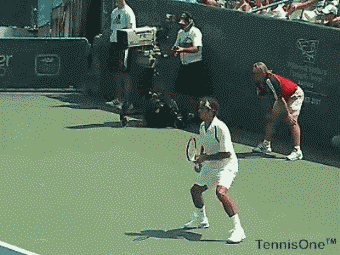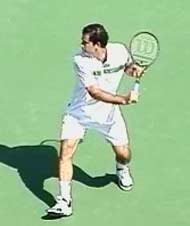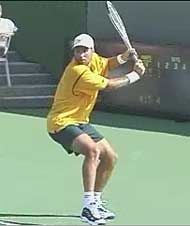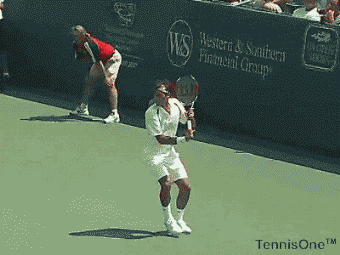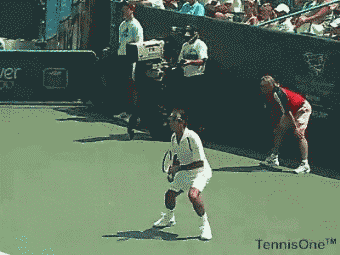|
TennisOne Lessons Another Look at the One-Handed Backhand I may have struck a nerve with last week’s newsletter, The US Open – Final Thoughts for the Players Perspective. I received a great deal of feedback, but particularly telling were the pros and con as regards to my comment that, “And as much as any other element within his game, it is the skill and variety of his one-handed backhand that sets Roger apart. Somehow, the two-handers rarely develop the knack for approaching and net game. Further, the one-handed backhand creates options for wicked under spin as well as penetrating topspin drives and passing shots.” I can still see the heavy backhand return from the deuce court against a 140 mph serve, the whipping topspin pass to clinch the tiebreaker in the first set against Andy, the laser like topspin down the line pass on set point in the second set tiebreaker against Djokovic, and finally the delicate 45 mph backhand chip return that forced the error on championship point. The one-hander speaks of versatility and variety, and though somewhat of a rarity in the junior and adult ranks, the shot, when mastered, provides many avenues for players of all abilities.
The two-handed aficionados complained that their stroke has less moving parts and is easier to learn. When starting the game at a young age players will naturally gravitate to that stroke. And finally, that no inverse connection exists between volleying skills and two-handed backhands. This article is not meant to dissuade any of you from your two-handed skills. But for anyone who enjoys watching the style of the one-handed backhands, as well as anyone trying to improve their own backhand, the following may be useful. If you are keen to learn, read on. Step one - the grip. First and foremost, the eastern backhand grip enables you to stroke the ball with topspin or under spin. Many attempt this shot with a continental grip, but to follow Roger’s lead, the eastern backhand grip is truly step one.
If you are sitting at a table, as I am now, and you rest your palms on either side of your keyboard, the palm down position resembles the eastern backhand grip, in that the palm is placed more or less on top of the handle (as opposed to the eastern forehand where the palm is placed behind the handle). Certainly the nuances of grip complicate the game, but no one I know ever said tennis was easy, and unfortunately those looking for quick fixes are loath to attempt this stroke. But the journey, which begins with this first step, is well worth the effort. Step two - the turn. All strokes begin with a simple turn of the hips and shoulders to the side, in this case turning to the backhand side. Tom Stow called this the “ready position” (for the backhand, or forehand) and referred to the ready position as the “waiting position.” And though counterintuitive, he taught that one was never “ready” to hit the ball until they had turned hips and shoulders and balanced the weight on the back foot. Step three – keep the racquet head up. If the racquet head is above the hands in your “waiting position” then it should remain up during and at the completion of the turn. Federer takes the racquet head well up at this moment, as do Pete Sampras, Ken Rosewall, and Patrick Rafter.
And before going further, a distinction between the one and two-hander. I have studied Roddick, Courier and Agassi and note how they prepare differently for the occasional one handed slice. Generally when stretched wide they float the ball crosscourt to get back into position. But therein lies the rub, when resorting to the one-hander, the tell occurs when they prepare with the racquet high and opened face, and the savvy opponent (which would include the likes of McEnroe and Federer) will have already cheated into the backhand corner. Those guys can generally drive the two-hander up the line or crosscourt, but we just don’t see the one-hander with any “stick” or purpose, and rarely up the line. But when the one-hander is in a similar position, they have more options and can play more effectively up the line (Federer topspin winner set point second set tiebreaker Djokovic), dip the ball crosscourt (Federer topspin crosscourt pass first set tiebreaker Roddick) or feather the ball short to make the opponent approach. Years ago in the juniors I discovered a version of this play, though certainly far less developed, where I shorted the ball to shorten the rally and make the opponent come forward and do something. And with the preponderance of the "Big Defense" played from well behind the baseline, accompanied by uncertain volleying skills, the backhand chip is worth its weight in gold (wish James Blake was reading this).
And one more aside. Years ago warming up for the Siebel Open final in San Jose, Sampras took a few at the net and all skimmed deep and inches from the baseline. Agassi followed, and truly on two occasions his volley was mishit and bounced twice before reaching Sampras. That was Agassi’s last foray to the net, and it spoke volumes about the discomfort the two-handers (including Lleyton Hewitt, Andy Roddick, and Novak Djokovic – note Nadal has made unusual progress in this area) find on the backhand wing at the net. I do not disparage the two-handers baseline skills, but personally I see a connection between that stroke and generally underdeveloped “moving forward” type skills. Yes the players pass with more topspin, yes net rushers are a dying breed, but come on, there is a lot more to this game than grinding, which also includes doubles. Step four – now the fun begins. When in the backhand “ready position” with the racquet well up, you can experiment with a circular topspin swing, swooping quickly under and then up at the ball, and equally a severe down swing to create either a wicked slice (Federer) or a heavy drive (Rosewall).
Studying Roger or Pete, both start the topspin stroke with this high circular start. Momentum, timing, rhythm, but all with a heavy upward hit. Often players have been trained to prepare with the racquet head down below the hips (this also occurs with two-handed training, note Venus Williams) but this low start will obscure rhythm and disguise and kill any opportunity to develop the under spin. Starting high creates more of a swooping topspin Timing is tricky, but again well worth the effort on your part. Step five – underspin. Take the racquet back equally high in the backhand “ready position” but swing down on the ball, and experiment with heavy underspin, floaters, drop shots, dinkers, and even a Rosewall-like underspin drive. The nuance here lies in varying the racquet speed, steepness of the swing, and angle of the racquet face. Rafter, Edberg and McEnroe used this stroke to drive the ball firmly when approaching up the line on the backhand wing. Mac and Federer use this stroke when feathering delicate under spin chips. And Federer, more than any other player, uses this stroke when swinging fast to produce a wicked low bouncing backhand, and this truly drives the "Big Defenders" nuts. Step six – learn to read the ball. The one-hander will generally feel less comfortable when met at or above shoulder height, and many readers have noted the difficulty of generating topspin at this point of contact. The secret lies in matching the swing to the flight of the incoming ball, meaning swing up at the down ball and swing down on the up ball. What? Simple, if the ball ascends into your contact zone rising up toward your shoulder, simply select the downward swing. Really! And if the ball descends into your contact zone between your waist and knees, then just swing up. This can and should first be practiced on the ball machine, varying your court position to purposely place yourself into ascending or descending zones. Once mastered, take it to the court. Years ago, a young Pete Sampras watched Rod Laver movies, and became inspired to build a versatile all court one-handed game. And boy did he ever. I can only hope there are a number of youngsters out there today watching and emulating Federer, so we can be treated yet again to an all court champion. Your comments are welcome. Let us know what you think about Jim McLennan's article by emailing us here at TennisOne.
|
||||||||||||||

